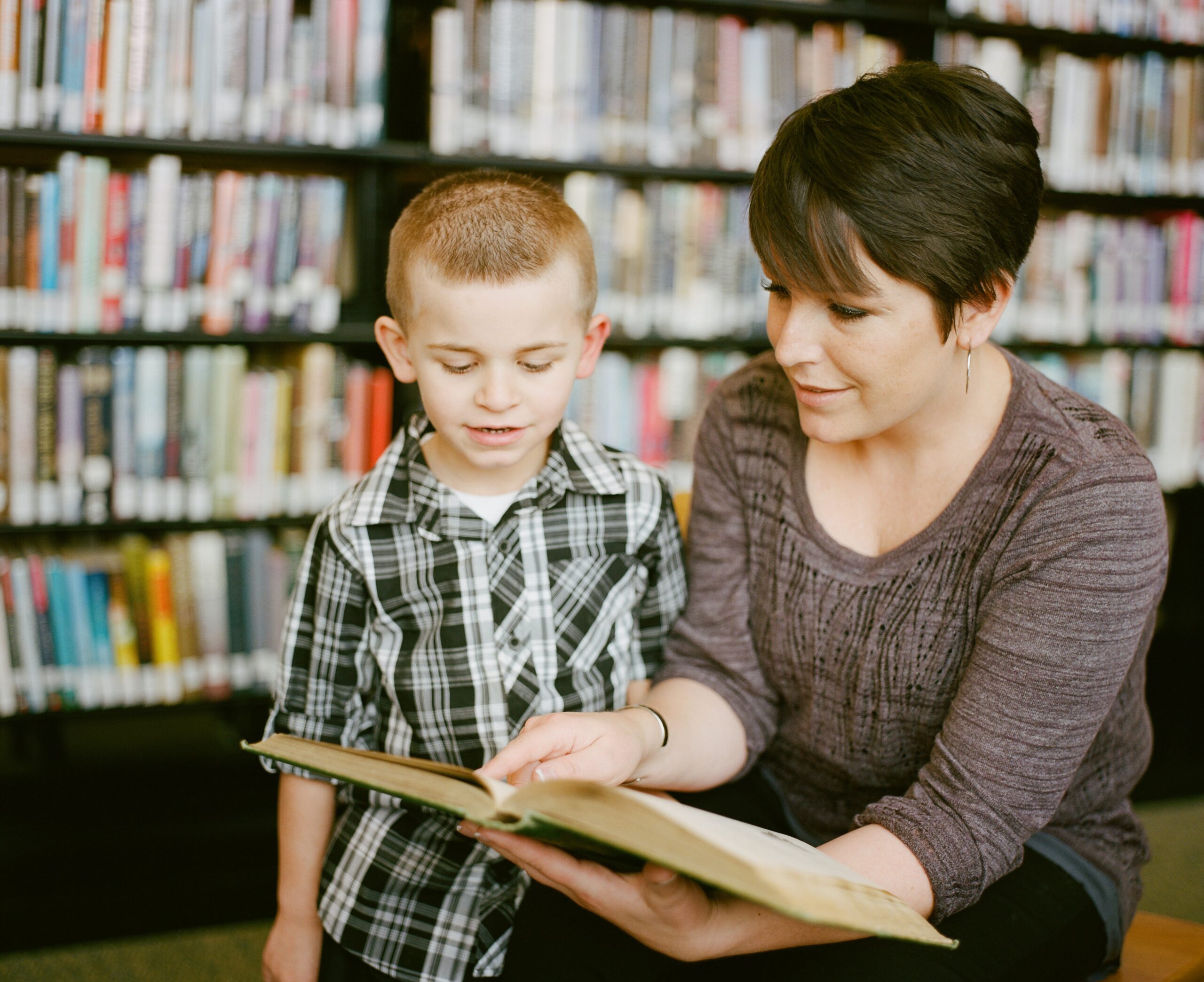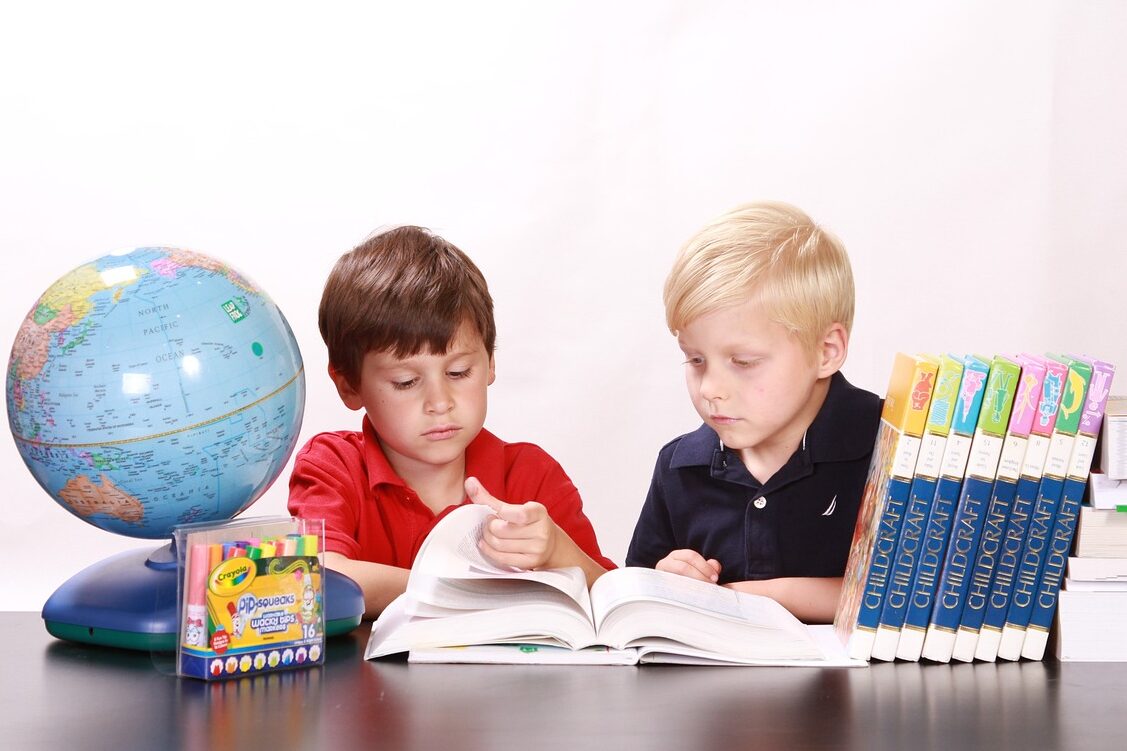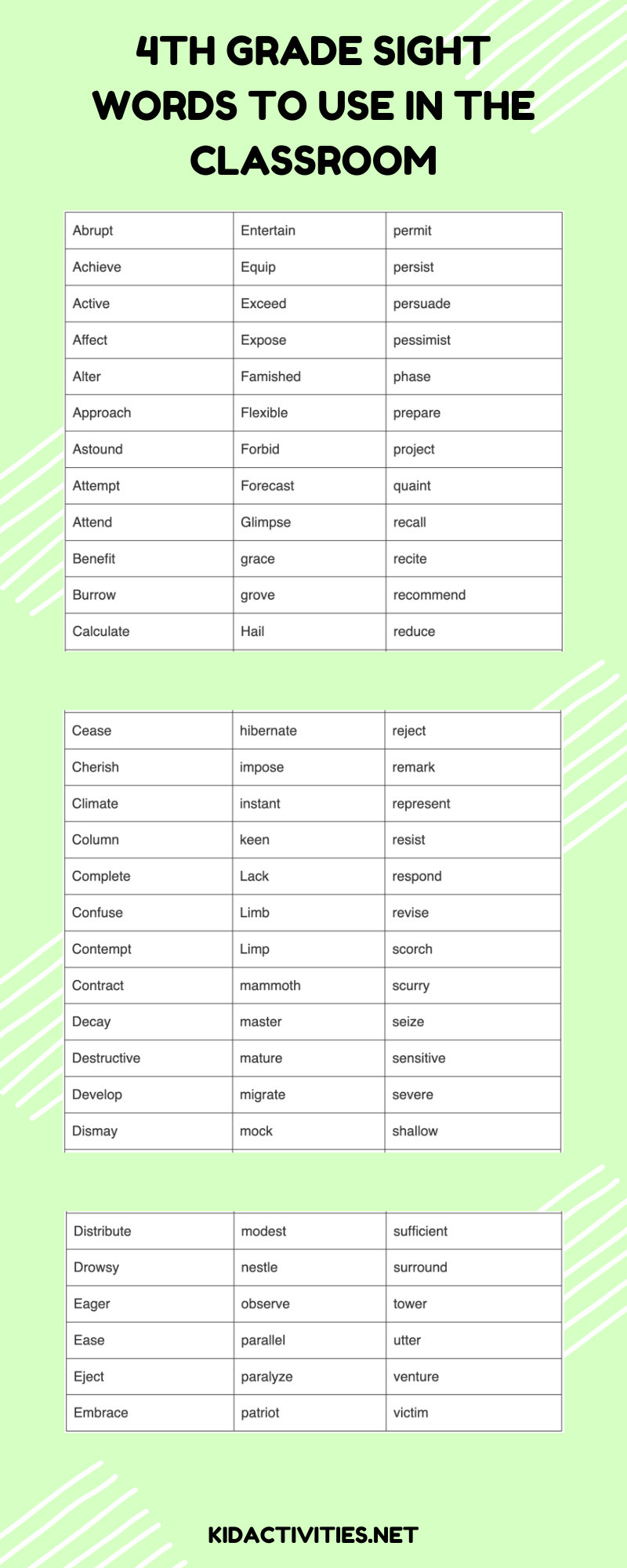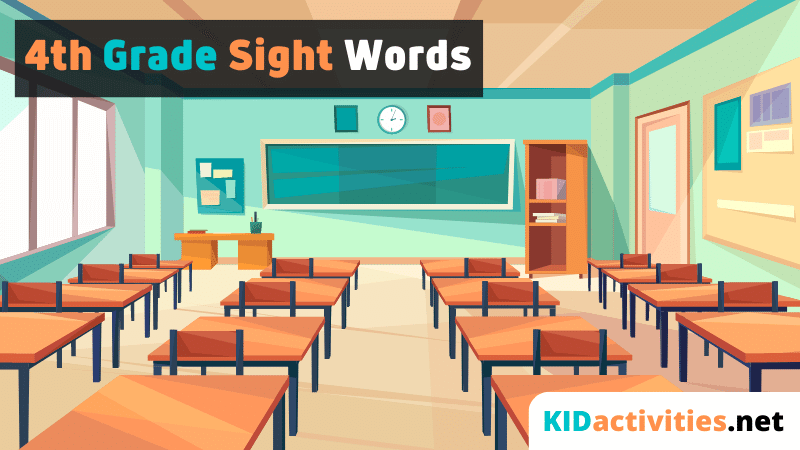Reading is one of the most difficult things to learn. Reading acts as a gateway to understanding and imagination. Of course, for children reading is essential to their education and they need it at any time of their academic journey. But, it is worth noting that the skill of reading is a helpful combination of many things.
Below is our list of sight words for the forth grade and you can keep reading the helpful information below if you want:
| Abrupt | Entertain | permit |
| Achieve | Equip | persist |
| Active | Exceed | persuade |
| Affect | Expose | pessimist |
| Alter | Famished | phase |
| Approach | Flexible | prepare |
| Astound | Forbid | project |
| Attempt | Forecast | quaint |
| Attend | Glimpse | recall |
| Benefit | grace | recite |
| Burrow | grove | recommend |
| Calculate | Hail | reduce |
| Cease | hibernate | reject |
| Cherish | impose | remark |
| Climate | instant | represent |
| Column | keen | resist |
| Complete | Lack | respond |
| Confuse | Limb | revise |
| Contempt | Limp | scorch |
| Contract | mammoth | scurry |
| Decay | master | seize |
| Destructive | mature | sensitive |
| Develop | migrate | severe |
| Dismay | mock | shallow |
| Distribute | modest | sufficient |
| Drowsy | nestle | surround |
| Eager | observe | tower |
| Ease | parallel | utter |
| Eject | paralyze | venture |
| Embrace | patriot | victim |
It’s the missing puzzle of investigating new ideas, new cultures, and discovering new perspectives. Reading is a tool to even find out new adventures and widen children’s minds to a new world.

For 4th-grade students, reading is coming actually from their introduction to the world of sight words. These seemingly ordinary words hold extraordinary power, allowing young readers to unlock the door to fluency and comprehension.
Sight words are the building blocks of early literacy, encompassing high-frequency words that appear repeatedly in texts. Unlike phonetically decodable words, which adhere to predictable spelling patterns, sight words do not follow traditional rules and require memorization through repeated exposure.
The journey of 4th-grade sight words is nothing short of captivating. It marks a pivotal moment in a student’s reading journey, where the groundwork laid in previous grades converges to facilitate a deeper understanding of the written language.
As 4th-grade learners encounter more complex texts and delve into a myriad of literary genres, the mastery of sight words becomes an essential factor in their ability to comprehend and interpret what they read.
These sight words serve as the stepping stones that bridge the gap between the mechanics of reading and the true essence of literature.
In this article, we embark on an exploration of the enchanting world of 4th-grade sight words. We shall unravel the significance of these unassuming words and their transformative impact on young minds as they venture into the realms of knowledge and creativity.
We will delve into the effective teaching strategies employed by educators to make sight word learning engaging and enjoyable for their students. As we unlock the secrets of 4th-grade sight words, we will uncover the profound connection between sight word mastery and the development of confident, enthusiastic, and lifelong readers.
So, read below and learn everything you need to know about the sight words, along with the more common sight words in our vocabulary.
What are Sight Words?
Sight words are a critical component of early literacy development and play a fundamental role in a child’s journey toward becoming a proficient reader.
These are commonly used words that appear frequently in written texts, regardless of their complexity or subject matter. Sight words are unique in that they do not follow regular phonetic rules, making them challenging to decode using standard phonics strategies. Instead, they must be recognized on sight, hence the name “sight words.”
Characteristics of Sight Words
- High Frequency: Sight words are among the most frequently used words in the English language. They appear repeatedly in written texts, making up a significant portion of any text.
- Non-phonetic: Sight words often do not follow standard phonetic rules, meaning they cannot be easily decoded using phonics skills alone. Instead, they require memorization and recognition by sight.
- Irregular Spelling: Many sight words have irregular spellings that deviate from typical spelling patterns. For example, words like “said,” “was,” and “come” are considered sight words because their spelling cannot be deduced phonetically.
- Foundational for Reading: Mastering sight words is a crucial step in developing reading fluency. As students internalize these words, they can read more smoothly and focus on comprehension rather than struggling with word recognition.
- Words with High Utility: Sight words are often words that are essential for communication and understanding written texts. They include common pronouns, prepositions, conjunctions, and frequently used verbs and adjectives.
- Relevance to Everyday Language: Many sight words are words commonly used in daily conversations, which is why recognizing them is crucial for effective communication.
- Quick and Automatic Recognition: The goal of sight word instruction is for students to recognize these words instantly, without hesitation or the need for decoding. Rapid recognition helps improve reading speed and comprehension.
- Cumulative Learning: As students progress in their reading journey, they build upon their knowledge of sight words. New sight words are introduced while previously learned sight words are reinforced.
- Important for Reading Comprehension: Sight words are often used to convey crucial information and relationships between words in a sentence. Understanding sight words is essential for comprehending the overall meaning of a passage.
- Reinforcement through Repetition: Sight words are best learned through repeated exposure and practice. Consistent reinforcement helps solidify recognition and retention.
Sight words are foundational building blocks in the process of learning to read. Their unique characteristics and high frequency in written texts make them key elements in developing early reading proficiency and fostering a love for reading in young learners.
Differentiating Sight Words from Phonetically Decodable Words
Reading sight words differs from reading phonetically decodable words in the following ways:
Sight Words: Phonics rules can’t decode sight words. Instead, they are memorized through repeated exposure, and their recognition becomes automatic. Some examples of sight words are “the,” “and,” “was,” and “have.”
Phonetically Decodable Words: Phonetically decodable words follow regular spelling patterns and can be sounded out using phonics rules. As children learn letter-sound relationships, they can apply these rules to decode unfamiliar words. Some of the most common phonetically decodable words are “cat,” “run,” “man,” and “hop.”
The distinction between sight words and phonetically decodable words is essential for educators and parents alike. While phonetically decodable words are essential for building foundational reading skills, sight words are equally critical in developing reading fluency and comprehension.
Both types of words complement each other to create well-rounded readers capable of navigating various texts with confidence and understanding.
The Significance of 4th-Grade Sight Words
Sight Words for 4th Graders
As 4th-grade students progress in their educational journey, their reading proficiency reaches a crucial juncture. At this stage, they encounter more sophisticated texts that demand a higher level of comprehension and critical thinking.
To navigate these challenging materials successfully, 4th-grade students need to have a solid grasp of sight words.
Here is a curated list of sight words that are particularly relevant and appropriate for 4th-grade learners:
- about
- above
- across
- after
- again
- almost
- along
- also
- always
- another
- away
- become
- before
- behind
- believe
- better
- between
- both
- bring
- could
- does
- even
- every
- first
- found
- from
- goes
- great
- help
- here
- high
- how
- its
- just
- know
- large
- little
- long
- many
- more
- most
- much
- must
- new
- only
- other
- our
- own
- people
- put
- right
- said
- same
- saw
- should
- some
- than
- their
- them
- then
- there
- these
- they
- think
- through
- too
- under
- use
- very
- want
- well
- went
- what
- when
- where
- which
- who
- why
- will
- with
- work
- would
- year
- your
This list mentioned above includes sight words that repeatedly appear in 4th-grade reading materials. By learning these words, young students can improve their reading fluency and comprehension, which are essential skills in accessing and studying more difficult texts.
Most Common Sight Words Encountered in 4th-Grade Reading Materials
The mastery of sight words is a critical milestone for 4th-grade students, as these words make up a substantial portion of the texts they encounter in various subjects. Some of the most common sight words encountered in 4th-grade reading materials include:
| the | and |
| of | a |
| to | in |
| is | that |
| you | it |
| he | on |
| for | are |
| with | they |
| I | his |
| at | be |
- this
- have
- from
- or
- one
- had
- by
- words
- but
- not
- what
- all
- were
- we
- when
- your
- can
- said
- there
- use
- an
- each
- which
- she
- do
- how
- their
- if
Recognizing these high-frequency sight words empowers 4th-grade students to read more smoothly and comprehend the context of the text effectively. As they internalize these words, 4th graders can devote more attention to understanding the deeper meaning of the content they encounter in their academic pursuits.
Learning sight words unlocks the magic of reading, and it prepares 4th-graders to explore new ideas, engage with diverse perspectives, and embark on endless journeys of learning and discovery.
The Link Between Sight Word Mastery and Reading
Sight word mastery plays a crucial role in achieving 4th-grade reading proficiency. Young readers need these high-frequency words to read fluently and understand what they’re reading.
When students are familiar with sight words, it becomes simpler for them to concentrate on comprehending the meaning of a text.
As students encounter more complex texts in 4th grade, sight word recognition becomes increasingly important. Proficient recognition of sight words allows students to quickly identify familiar words and phrases, leading to smoother and more efficient reading.
Consequently, this fluency enables them to dedicate more cognitive resources to understanding the content, context, and underlying themes of the text.
Moreover, sight word mastery is linked to vocabulary development. Many sight words are high-utility words that serve as the gateway to understanding more sophisticated vocabulary.
As students read and encounter these sight words in various contexts, their overall word knowledge expands, contributing to improved reading comprehension.
In essence, sight word mastery provides 4th-grade readers with a solid foundation for reading success. Facilitating a love for reading and learning prepares them to navigate grade-level texts.
The magic of reading opens endless doors for children when educators and parents nurture sight word proficiency in young readers.
Strategies for Introducing Sight Words
Introducing sight words in a way that captures the attention of young learners will foster a positive and engaging learning experience. Here are some effective strategies for introducing sight words:

- Word Walls: Create a word wall in the classroom displaying sight words prominently. This visual aid serves as a reference point for students, helping them reinforce sight word recognition and spelling.
- Flashcards: Use flashcards with sight words on one side and corresponding images or sentences on the other. Flashcards make sight word practice interactive and engaging, allowing students to flip the cards and test their recognition skills.
- Multi-Sensory Approaches: Incorporate multi-sensory techniques, such as tracing sight words in sand or shaving cream, using magnetic letters to spell sight words, or forming them with play dough. These hands-on activities engage different senses, enhancing memory and learning.
- Contextual Learning: Introduce sight words in sentences or short stories, providing significant context for students to understand their usage and meaning within the context of language.
- Interactive Technology: Utilize educational apps, websites, or interactive whiteboards to engage students in sight word learning through interactive games and quizzes. Technology can make learning fun and appealing to tech-savvy students.
- Sight Word Sentences: Create sentence strips with sight words strategically placed. As students read these sentences, they gain a deeper understanding of how sight words contribute to the overall meaning and flow of language.
- Phonics Connections: Teach sight words alongside phonics instruction, helping students understand the relationship between sight words and phonetically decodable words. This approach enhances reading skills and overall word recognition.
- Word Hunts: Encourage students to find sight words in books, magazines, and other written materials, making sight word recognition a treasure hunt. This activity promotes active reading and reinforces the importance of sight words in everyday reading.
- Partner and Group Activities: Engage students in partner or group activities like sight word relay races or sight word bingo, promoting collaboration and friendly competition. Group activities foster a supportive learning environment and make learning enjoyable.
- Storytelling and Visualization: Incorporate storytelling and visualization techniques to make sight words memorable. Encourage students to create stories using sight words or draw pictures representing the meaning of sight words.
- Repetition and Practice: Encourage frequent repetition and practice of sight words through games, activities, and reading exercises to reinforce recognition and retention. The more exposure students have to sight words, the more confident they become in reading them.
Incorporating Technology for Interactive Sight Word Learning
Sight word learning can be fun and interactive in today’s digital age thanks to technology. Games and activities on educational apps and websites challenge and reinforce sight word recognition.
Using technology, it is possible to provide customized learning experiences, tailored to the ability level and pace of each student. Teachers can track individual progress more effectively when they integrate technology into sight word instruction.
Engaging Activities and Games
Instilling a love for sight words in young learners requires making learning fun. Sight word learning can be made enjoyable and memorable by incorporating engaging activities and games. Here are two good examples:
Sight Word Games that Make Learning Enjoyable and Memorable Games offer an exciting way to reinforce sight word recognition. For instance, “Sight Word Bingo” involves creating bingo cards with sight words randomly arranged.
As the teacher calls out sight words, students mark the corresponding words on their cards. The first student to bingo shouts “Bingo!” and wins the round.
Another popular game is “Sight Word Memory Match,” where students flip cards to find matching sight words and their corresponding images or sentences.
Creating Sight Word Scavenger Hunts and Interactive Competitions Scavenger hunts can be adapted for sight word learning by hiding sight word cards or post-it notes around the classroom or school.
Students work in pairs or teams, searching for the sight words and reading them aloud once found. To add an element of competition, consider organizing interactive sight word competitions.
A timed “Sight Word Dash” lets students read as many sight words as they can within a set amount of time. Such activities not only reinforce sight word recognition but also promote teamwork and friendly competition.

Engaging Sight Word Games for 4th-Grade Students
- Sight Word Bingo: Create bingo cards with various sight words randomly arranged. Call out sight words, and students mark the corresponding words on their cards. The first student to achieve a bingo shouts “Bingo!” and wins the round.
- Sight Word Memory Match: Create pairs of sight word cards with the word written on one card and an image or sentence using the word on another card. Students flip the cards to find matching pairs, reinforcing sight word recognition and its context.
- Sight Word Swat: Write sight words on sticky notes and stick them to a wall or whiteboard. Divide the class into teams and provide fly swatters. Call out sight words, and the first team to “swat” the correct word wins a point.
- Sight Word Scrabble: Give students letter tiles and sight word cards. Students use the tiles to spell the sight words on the cards, just like in the game Scrabble. Encourage them to build as many sight words as possible within a time limit.
- Sight Word Race: Set up a relay race with sight word flashcards placed at one end and an empty container at the other end. Divide students into teams and give each team a basket or bucket. The first student in each team runs to the sight word flashcards, reads one, and races back to drop it into their team’s container. The next student then goes and repeats the process. The team with the most correctly collected sight words wins.
- Sight Word Charades: Write sight words on index cards. Students take turns drawing a card and acting out the word without speaking, while their classmates guess the word. This is also a great game to improve the drama and acting skills of the student.
- Sight Word Puzzles: Create puzzles with sight words written on them. Students must put the puzzle pieces together to form the sight word while saying the word aloud.
- Sight Word Basketball: Attach sight word flashcards to a wall or whiteboard. Students take turns trying to shoot a small ball (soft foam ball) at the sight words. When a student makes a basket, they must read the sight word before retrieving the ball.
- Sight Word Scavenger Hunt: Hide sight word cards around the classroom or school grounds. Students search for the cards and read the sight words aloud as they find them.
- Sight Word Karaoke: Write sight words on a whiteboard or chart paper. Play some instrumental music and have students take turns singing the sight words to the tune of the song, making the learning experience fun and musical.
- Sight Word Caterpillar: Draw a caterpillar on the board or a large poster, with each segment representing a sight word. As students learn a new sight word, add a segment to the caterpillar. This visual representation allows students to see their progress as the caterpillar grows longer.
- Sight Word Theater: Organize a sight word theater performance where students act out short scenes or dialogues using sight words. This interactive and dramatic activity promotes sight word recognition while boosting students’ confidence in reading aloud.
- Sight Word Secret Code: Assign each sight word a unique symbol or code. Have students decode and read sight words written in these symbols. This game-like activity adds an element of mystery and excitement to sight word learning.
- Sight Word Art Gallery: Turn sight word recognition into an art project. Provide students with art supplies and ask them to create colorful posters or artwork featuring sight words. Display their creations around the classroom for a sight word art gallery.
- Sight Word Mystery Bag: Fill a bag with objects representing different sight words. Students take turns reaching into the mystery bag, feeling the object, and identifying the sight word it represents.
Contextual Learning and Reading Comprehension
Teaching sight words in context is crucial for developing reading comprehension. It’s easier for students to understand how sight words work when they’re used in meaningful sentences and stories. Sight words can be learned contextually with these two strategies:
Integrating Sight Words into Sentences and Stories for Context-Based Learning
Students learn their meanings and usage in real-life situations when sight words are incorporated into sentences and stories. With sight words strategically placed, teachers can make sentence strips or short stories. This helps students understand how sight words contribute to the overall meaning of sentences and stories.
Enhancing Reading Comprehension through Sight Word Recognition
Readers become more confident and fluent as they learn sight words. Students can focus more on comprehending content and making connections when sight words are automatically recognized. By mastering sight words, students can engage more deeply with the text and extract more information, resulting in enhanced comprehension.
4th-grade students can develop sight word proficiency by utilizing these effective strategies and activities. Learning to recognize sight words builds a solid foundation for reading comprehension and a passion for reading for a lifetime.

Sight Words and Vocabulary Development
Sight words are crucial to building a strong vocabulary, as they serve as stepping stones for a child’s linguistic development. Sight words, being high-frequency words, are encountered frequently in various texts.
By memorizing and recognizing these words on sight, kids gradually incorporate them into their vocabulary. By consistently exposing and practicing sight words, students develop a deep familiarity with words.
Sight words act as a foundation for vocabulary development because many of them are essential words used in everyday language and written communication.
Through exposure to these words in different settings and contexts, children learn their meanings and how to use them effectively. This process of contextual learning strengthens their understanding of sight words and expands their overall vocabulary.
How Sight Words Expand a Child’s Word Knowledge
- Word Recognition: Sight word mastery enables children to recognize and read these words with ease, helping them quickly identify and understand commonly used words in texts.
- Meaningful Context: Sight words often appear in sentences and stories, providing a meaningful context for children to comprehend their usage and meaning.
- Language Fluency: As students become fluent in recognizing sight words, they gain confidence in their reading abilities, which motivates them to explore more texts and discover new words.
- Transferable Skills: The cognitive process of learning sight words involves pattern recognition, which can be applied to other words and language structures.
- Reading Comprehension: A robust vocabulary, built upon sight words, enhances reading comprehension by facilitating a deeper understanding of the text.
Assessing Sight Word Proficiency
In order to track students’ progress and identify areas that need to be improved, assessing sight word proficiency is an important part of tracking students’ progress. A combination of formal and informal assessment methods plays an essential role in determining the level of mastery of sight words among 4th-grade students.

Designing Sight Word Assessments for 4th-Grade Students:
It’s important to design formal sight word assessments that cover a wide range of sight words aligned with the Fourth Grade curriculum. Sight word assessments should include the elements below:
- Comprehensive Word List: Make a list of sight words that are appropriate for 4th grade. There should be a mix of high-frequency words and sight words commonly encountered in 4th-grade texts.
- Variety of Formats: Use a variety of assessment formats to assess a student’s skill, such as multiple choice questions, fill-in-the-blank sentences, and identifying sight words in context using a variety of assessment formats. By using this wide range of sight words, students’ proficiency in sight words will be evaluated in a comprehensive way.
- Progressive Difficulty: It is a good idea to organize sight words by difficulty in order for students to be able to identify both familiar words and words that are more challenging.
- Timed and Untimed Assessments: To determine how quickly and with what accuracy students recognize sight words, conduct both timed and untimed assessments.
Integrating Sight Word Evaluations into Regular Classroom Activities
Informal assessments can be seamlessly integrated into regular classroom activities to gauge students’ sight word recognition in authentic contexts. Some effective ways to do this include:
- Reading Aloud: Observe students’ sight word recognition as they read aloud during reading circles or independent reading sessions.
- Writing Tasks: Review students’ writing assignments to identify their accurate usage of sight words.
- Interactive Activities: Assess sight word proficiency through interactive activities, such as sight word games, group discussions, and sight word scavenger hunts.
- Word Walls: Observe students as they interact with the word wall and identify sight words in the classroom environment.
Using Data to Monitor Students’ Sight Word Growth
Analyzing data from formal and informal assessments is key to tracking students’ sight word growth. The data allows you to see what students are good at and what they need to improve on. Spreadsheets, progress charts, and educational software can be used to track sight word progress.
By analyzing the data, teachers and parents can identify trends and patterns in sight word recognition, and tailor instruction to meet each student’s needs.
Aside from helping educators and parents adjust instructional strategies for effective sight word mastery, data-driven insights can help them make better decisions.
It’s important to remember that sight words play a huge role in early reading development, serving as stepping stones to reading proficiency. By using effective and captivating strategies, educators can get kids interested and motivated in sight words.
Multi-sensory activities, word walls, flashcards, and contextual learning create a dynamic learning environment that helps kids recognize and understand sight words.
Integrating interactive technology, games, and personalized practice ensures that sight word instruction remains enjoyable and tailored to each student’s needs. Through sight word mastery, students gain confidence and fluency to explore diverse texts, fostering a lifelong love of reading.
Students become confident and enthusiastic readers when sight words are reinforced through repetition, progress tracking, and celebrations. Reading comprehension and word knowledge grow as sight word proficiency grows.
By implementing these effective strategies, educators and parents sow the seeds of a lifelong passion for reading and learning in their students. The unique characteristics of sight words make them essential for future academic success and the creation of a world filled with endless possibilities.
Teachers and parents inspire confidence, skill, and joy in their students by using sight words. This unlocks a world of imagination, knowledge, and discovery through dedication, creativity, and sight words.
Infographic of sight words to use in the classroom


